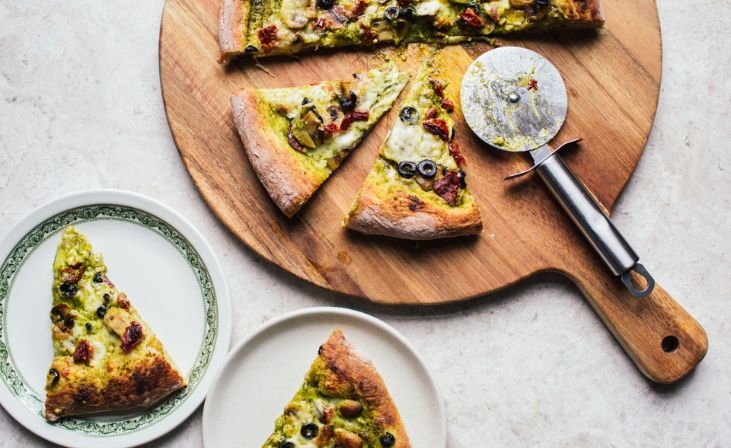Gourmet Portobello Pesto Pizza is a delightful fusion of earthy mushrooms, aromatic pesto, and creamy cheese, all atop a perfectly crispy crust. This pizza is not just a meal but an experience, combining unique flavors and textures to create a culinary masterpiece. Unlike traditional pizzas, which rely heavily on tomato sauce and a variety of meats, the Portobello Pesto Pizza focuses on the rich, savory flavor of portobello mushrooms and the fresh, herbaceous notes of pesto.
History of Pizza and the Evolution of Gourmet Varieties
Pizza has a long and storied history, originating in Naples, Italy, in the 18th century. Originally a simple dish made with basic ingredients like tomatoes, cheese, and bread, pizza has evolved into a versatile platform for culinary creativity. The concept of gourmet pizza emerged in the late 20th century as chefs began experimenting with non-traditional ingredients and artisanal techniques. Gourmet pizzas often feature high-quality, fresh ingredients and innovative flavor combinations, elevating pizza from fast food to a sophisticated dining option.
Why Portobello Pesto Pizza is a Unique Culinary Experience
Portobello Pesto Pizza stands out in the world of gourmet pizzas due to its distinctive ingredients and balanced flavor profile. The meaty texture of portobello mushrooms makes them an excellent substitute for meat, providing a satisfying umami flavor. Pesto, with its blend of basil, garlic, pine nuts, Parmesan cheese, and olive oil, adds a vibrant, fresh element that complements the mushrooms perfectly. Together, these ingredients create a pizza that is both hearty and refreshing, making it a unique and memorable dining experience.

Ingredients and Nutritional Benefits
Key Ingredients in Portobello Pesto Pizza
Portobello Mushrooms
Portobello mushrooms are the star ingredient of this pizza. Known for their large size and dense, meaty texture, they are a popular choice for vegetarian dishes. When cooked, portobellos develop a rich, savory flavor that pairs beautifully with pesto and cheese.
Also Read – 2024’s Best Cheesy Meat Loaf Minis Recipe
Pesto Sauce
Pesto sauce is a classic Italian condiment made from fresh basil, garlic, pine nuts, Parmesan cheese, and olive oil. Its vibrant green color and fresh, herbal flavor make it an excellent alternative to tomato sauce on pizza. Pesto is not only delicious but also packed with nutrients like vitamins A and C, calcium, and healthy fats.
Cheese Varieties
While mozzarella is the traditional choice for pizza, gourmet variations like Portobello Pesto Pizza can benefit from the inclusion of other cheeses. Fresh mozzarella, goat cheese, and even gouda can add different textures and flavors, enhancing the overall experience.
Crust Options
The crust is the foundation of any pizza, and there are several options to choose from. Traditional pizza dough, whole grain crusts, and gluten-free alternatives can all be used. Each type of crust offers a different texture and flavor, allowing you to customize the pizza to your preference.
Nutritional Benefits of Each Ingredient
Health Benefits of Portobello Mushrooms
Portobello mushrooms are low in calories and fat but high in essential nutrients like selenium, potassium, and B vitamins. They are also a good source of dietary fiber and antioxidants, which can help reduce inflammation and support overall health.
Nutritional Value of Pesto Sauce
Pesto sauce is rich in vitamins and minerals thanks to its fresh ingredients. Basil provides vitamins A and C, garlic offers antioxidants, and olive oil supplies healthy monounsaturated fats. Together, these ingredients make pesto a nutritious addition to the pizza.
Cheese: Nutritional Pros and Cons
Cheese is a good source of calcium and protein, essential for bone health and muscle maintenance. However, it is also high in saturated fat and calories, so it should be consumed in moderation. Choosing lower-fat cheese options or using less cheese can help balance the nutritional profile of the pizza.
Whole Grain vs. Gluten-Free Crusts
Whole grain crusts offer more fiber and nutrients compared to traditional white flour crusts, supporting digestive health and providing sustained energy. Gluten-free crusts are essential for those with gluten sensitivities or celiac disease and can be made from various alternative flours like almond or rice flour.
Preparation Steps
Selecting Fresh Ingredients
The quality of your ingredients significantly impacts the final product. Choose fresh, organic portobello mushrooms, high-quality olive oil, and freshly grated Parmesan cheese. Fresh basil leaves are crucial for making vibrant pesto, and using fresh mozzarella will ensure the best texture and flavor.
Preparing the Portobello Mushrooms
Start by cleaning the portobello mushrooms with a damp cloth to remove any dirt. Remove the stems and, if desired, scrape out the gills to reduce moisture. Slice the mushrooms into thick pieces or leave them whole for a heartier bite. Marinating the mushrooms in olive oil, garlic, and a splash of balsamic vinegar can enhance their flavor before cooking.
Making Homemade Pesto Sauce
Homemade pesto is easy to make and far superior in taste compared to store-bought versions. In a food processor, combine fresh basil leaves, garlic, pine nuts, and Parmesan cheese. Slowly drizzle in olive oil while blending until you achieve a smooth, thick consistency. Season with salt and pepper to taste.
Assembling the Pizza
Roll out your pizza dough on a floured surface to your desired thickness. Spread a generous layer of pesto sauce over the dough, leaving a small border for the crust. Arrange the portobello mushroom slices evenly on top, followed by slices of fresh mozzarella or your chosen cheese.
Baking to Perfection
Preheat your oven to its highest setting, typically around 500°F (260°C), and place a pizza stone inside if you have one. Transfer the assembled pizza to the preheated stone or a baking sheet. Bake for 10-15 minutes, or until the crust is golden and the cheese is bubbly and slightly browned. Let the pizza cool for a few minutes before slicing and serving.
Cooking Techniques
Grilling vs. Baking Portobello Mushrooms
Grilling portobello mushrooms can add a smoky flavor that enhances their natural umami taste. Simply brush the mushrooms with olive oil and season with salt and pepper before placing them on a hot grill. Cook for 4-5 minutes per side. Baking, on the other hand, can concentrate the mushrooms’ flavors and is a convenient method if you’re already using the oven for the pizza. Both methods work well, so choose based on your preference and available equipment.

Achieving the Perfect Crust
A great pizza crust is crispy on the outside and chewy on the inside. Using a pizza stone can help achieve this by distributing heat evenly and absorbing excess moisture. For an extra crispy crust, pre-bake the dough for 5 minutes before adding toppings. Another tip is to brush the crust with olive oil before baking, which helps it turn a beautiful golden brown.
Balancing Flavors: Pesto and Cheese
Pesto is a strong, aromatic sauce, so it’s important to balance its flavor with the cheese and other toppings. Fresh mozzarella is mild and creamy, providing a perfect counterpoint to the pesto. If you prefer a stronger cheese, goat cheese or feta can add tanginess that complements the pesto’s herbal notes. Be mindful not to overload the pizza with too many toppings, as this can make it soggy and overwhelm the flavors.
Variations and Customizations
Vegetarian and Vegan Options
To make a vegetarian Portobello Pesto Pizza, simply ensure all ingredients are plant-based. Vegan cheese alternatives made from nuts or soy can replace traditional cheese. Nutritional yeast can be added to the pesto for a cheesy flavor without dairy.
Adding Protein: Chicken, Sausage, or Tofu
For those who want to add protein, consider grilled chicken breast, crumbled Italian sausage, or marinated tofu. These options blend well with the flavors of pesto and mushrooms, making the pizza more filling and nutritious.
Exploring Different Cheeses: Mozzarella, Gouda, Goat Cheese
While mozzarella is a classic choice, experimenting with different cheeses can elevate your pizza. Gouda adds a smoky richness, while goat cheese provides a tangy contrast to the sweet and herbal pesto. Mixing cheeses can also create a more complex flavor profile.
Experimenting with Additional Toppings: Sun-dried Tomatoes, Arugula, Olives
Additional toppings like sun-dried tomatoes add a burst of sweetness and acidity, while fresh arugula provides a peppery bite. Olives can introduce a salty element that enhances the overall flavor. These toppings should be added after baking to maintain their texture and freshness.
Pairing and Serving Suggestions
Best Wine and Beverage Pairings
A well-paired beverage can enhance the dining experience. For Portobello Pesto Pizza, consider a crisp white wine like Sauvignon Blanc or a light red like Pinot Noir. For non-alcoholic options, sparkling water with a twist of lemon or a herbal iced tea can complement the flavors without overpowering them.
Side Dishes to Complement Portobello Pesto Pizza
Pair your pizza with simple, fresh side dishes like a mixed green salad with a light vinaigrette or a tomato and mozzarella caprese salad. Roasted vegetables or a garlic bread appetizer can also be great additions.
Presentation Tips for a Gourmet Experience
To create a gourmet presentation, drizzle some extra virgin olive oil or balsamic reduction over the finished pizza. Garnish with fresh basil leaves or a sprinkle of grated Parmesan. Serve on a wooden board for a rustic touch, and don’t forget to slice the pizza into even pieces for easy sharing.
Cultural and Culinary Insights
Regional Variations of Pesto
While traditional pesto alla Genovese is made with basil, garlic, pine nuts, Parmesan, and olive oil, there are many regional variations. Pesto Rosso from Sicily includes sun-dried tomatoes, while Pesto Trapanese uses almonds instead of pine nuts. Each variation offers a unique twist on the classic, providing endless possibilities for flavor experimentation.
Portobello Mushrooms in Global Cuisines
Portobello mushrooms are versatile and popular in various global cuisines. In Italian cooking, they are often grilled or stuffed. In American cuisine, they serve as a meat substitute in burgers and sandwiches. Their robust flavor and texture make them suitable for a wide range of dishes, from stir-fries to soups.
The Rise of Gourmet Pizza in Modern Dining
Gourmet pizza has become a significant trend in modern dining, driven by the demand for high-quality, unique culinary experiences. Restaurants and home cooks alike are exploring creative toppings, artisanal crusts, and gourmet ingredients to elevate the humble pizza into a sophisticated dish. This movement reflects a broader trend towards artisanal and locally sourced food, emphasizing freshness, quality, and creativity.
Also Read – The Ultimate Guide to Perfectly Grilled Fish Recipes
Health Considerations and Dietary Restrictions
Gluten-Free Options
For those with gluten sensitivities or celiac disease, gluten-free pizza crusts are essential. These can be made from various flours, including almond, rice, or chickpea flour. Store-bought gluten-free crusts are also widely available and provide a convenient alternative.
Dairy-Free and Vegan Alternatives
Dairy-free and vegan cheeses made from nuts, soy, or coconut can replace traditional cheese. Nutritional yeast can also be used to add a cheesy flavor to the pesto. Ensuring all ingredients, including the pesto, are free from animal products can make this pizza suitable for vegans.
Low-Calorie and Low-Carb Adaptations
For a lower-calorie or low-carb option, consider using a cauliflower crust or a thin, whole grain crust. Reducing the amount of cheese and using a light layer of pesto can also help decrease the calorie count. Adding more vegetables can increase the nutritional value and make the pizza more filling without adding extra calories.
Expert Tips and Tricks
Chefs’ Secrets to Perfect Portobello Pesto Pizza
Professional chefs recommend pre-cooking portobello mushrooms to remove excess moisture, ensuring the pizza doesn’t become soggy. Using a pizza stone or steel can help achieve a crispier crust. Additionally, fresh, high-quality ingredients make a significant difference in the final taste.
Common Mistakes to Avoid
Avoid overloading the pizza with too many toppings, which can make it soggy and difficult to cook evenly. Using fresh mozzarella instead of low-moisture mozzarella can prevent excess moisture. Also, ensure the oven is properly preheated to achieve the best crust texture.
Enhancing Flavor with Fresh Herbs and Spices
Fresh herbs like basil, oregano, and thyme can enhance the pizza’s flavor. A sprinkle of red pepper flakes can add a bit of heat, while a drizzle of truffle oil can introduce a luxurious, earthy aroma. Experimenting with different seasonings can help tailor the pizza to your taste.
Personal Stories and Testimonials
Home Cooks’ Success Stories
Many home cooks have shared their success stories with Portobello Pesto Pizza. From family dinners to dinner parties, this pizza has become a favorite for its unique flavor and ease of preparation. Some have even experimented with growing their own basil for the freshest pesto possible.

Restaurant Reviews: Best Places for Gourmet Portobello Pesto Pizza
Several restaurants have gained acclaim for their gourmet portobello pesto pizzas. Pizzerias in cities like New York, San Francisco, and Rome have put their unique spin on this dish, earning rave reviews from pizza enthusiasts and food critics alike.
Customer Testimonials and Feedback
Customers often highlight the balanced flavors and satisfying texture of Portobello Pesto Pizza. Many appreciate the vegetarian-friendly option that doesn’t compromise on taste. Feedback frequently includes praise for the freshness of the ingredients and the gourmet experience the pizza provides.
Conclusion
Gourmet Portobello Pesto Pizza combines the rich, savory flavor of portobello mushrooms with the fresh, herbaceous notes of pesto, creating a unique and satisfying culinary experience. High-quality ingredients, proper preparation, and balanced flavors are key to making this pizza a gourmet delight.
Encouragement to Try Making Gourmet Portobello Pesto Pizza at Home
Making gourmet Portobello Pesto Pizza at home is not only rewarding but also allows for endless customization. Whether you follow a traditional recipe or experiment with new variations, this pizza is sure to impress.
FAQs
What makes Portobello Pesto Pizza gourmet?
Portobello Pesto Pizza is considered gourmet due to its use of high-quality, fresh ingredients and its unique flavor combination. The use of portobello mushrooms, fresh pesto, and artisanal cheeses elevates it beyond traditional pizza varieties.
Can I use store-bought pesto?
Yes, store-bought pesto can be used as a convenient alternative to homemade pesto. However, homemade pesto typically offers a fresher taste and can be customized to your preference.
How do I prevent the pizza from becoming soggy?
Pre-cooking the portobello mushrooms, using fresh mozzarella instead of low-moisture mozzarella, and not overloading the pizza with toppings can help prevent sogginess. Baking the pizza on a preheated pizza stone or steel also ensures a crispy crust.
Is it possible to make this pizza gluten-free?
Absolutely! Use a gluten-free pizza crust made from alternative flours like almond, rice, or chickpea flour. Many grocery stores also offer pre-made gluten-free pizza crusts.
What are some creative topping ideas?
Creative topping ideas include sun-dried tomatoes, arugula, olives, roasted red peppers, and caramelized onions. These toppings can add additional layers of flavor and texture to your pizza.


